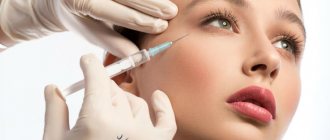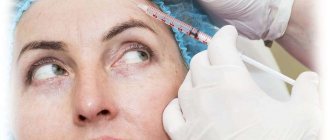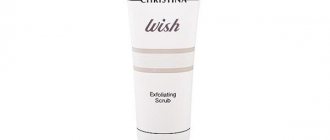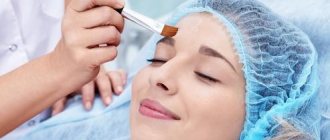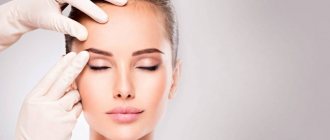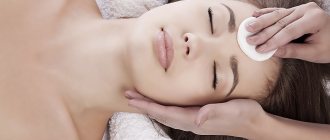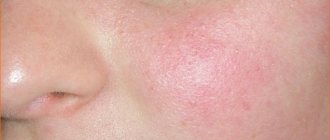The benefits and harms of the retinol component for pregnant women
Retinol is the main component of yellow (retinol, retinoic) peeling; during pregnancy, it can have both beneficial and harmful effects on the body of the expectant mother and child. In small doses, this vitamin is beneficial, but its excess can have adverse consequences.
Retinol has the ability to rapidly accumulate in tissues and organs, especially in the liver; for this reason, its dosage must be carefully monitored during pregnancy.
The benefit is as follows: this vitamin takes an active part in the synthesis of red blood cells. Blood cells transport oxygen and nutrients to tissues. Thanks to this, the fetus receives the optimal amount of microelements.
Retinol promotes the proper formation of important systems:
- cardiovascular;
- respiratory;
- bone;
- circulatory
Vitamin A is needed for proper development:
- organs of vision;
- brain and spinal cord;
- kidney
The substance provides support for a woman’s immunity during pregnancy and protects against pathogenic microorganisms. Retinol accelerates the regeneration of epidermal cells, which plays an important role during the recovery period after childbirth.
But even a slight excess of the dosage is fraught with the risk of premature aging of the placenta and the development of pathologies in the fetus. Approximately 2-3 months before planning a pregnancy, you need to abandon procedures aimed at rejuvenating the skin if retinol is used during them. This also applies to taking complexes containing this vitamin.
We recommend: Treating acne with peeling. Is it possible to do a procedure for acne and which one is better to choose?
Excess retinol in the body of a pregnant woman leads to damage to the internal organs of the fetus. The ones who suffer the most are:
- child's limbs;
- heart;
- reproductive and nervous systems;
- kidneys
Excessive amounts of retinol entering the body reduce the effect of vitamin D and provoke its deficiency.
Contraindications to retinoic peeling
Restrictions to retinoic peeling are:
- any violation of the integrity of the skin in the treatment area (cuts, burns, etc.);
- dermatological diseases (warts, seborrhea, eczema, etc.);
- acne in the active stage;
- individual intolerance to the components used;
- immunodeficiency;
- high photosensitivity of the skin;
- active infections, including herpes;
- serious diseases of the body, especially in the stage of decompensation (hepatitis, diabetes, etc.);
- recent use of retinoids (less than six months) and treatment with radiation, chemotherapy and antibacterial therapy;
- pregnancy, lactation - the last peeling with isotretionine (yellow) should be carried out at least six months before conception.
Many experts do not recommend carrying out the procedure before 35 years of age and during the summer season.
Effect on the embryo
Doctors are of the opinion that retinoids have a teratogenic effect, they negatively affect the process of fetal formation and provoke developmental pathologies.
For this reason, professionals from the beauty industry are trying to find out whether a woman has pregnancy plans in the near future and whether she is breastfeeding.
There are no scientifically proven facts that retinol, which penetrates into the body of the expectant mother from peeling preparations, provokes mutations in the fetus. But it was found that retinoic acid molecules have the ability to penetrate cell membranes and contact proteins in the cell nuclei. This process does not affect the transport of genetic chains from the mother to the baby’s body.
The amount of retinoic acid in the peel may not be enough to transform the genetic code.
Tests on the effects of retinoids on the fetus were performed exclusively on mice in laboratory conditions. No facts have been found to prove the teratogenic effect of vitamin A and its artificial analogues.
Pregnant women have never been tested for fetal pathologies under the influence of retinoic acid. For this reason, pregnancy and lactation are included in the list of contraindications for yellow peeling. In this case, doctors play it safe.
What should a woman do if she finds out she is pregnant after peeling?
It happens that a woman visited a beauty salon, successfully cleaned her face, and after some time found out that she had been pregnant for several weeks. Usually in such a situation, expectant mothers panic and don’t know whether to go for an abortion or leave the long-awaited baby.
Adding fuel to the fire are numerous forums where women tell how, after a course of peeling, they gave birth to a child with serious pathologies, hidden or obvious mutations. After reading such stories, expectant mothers themselves worsen their health with depression and nervous disorders.
Doctors rush to reassure women, citing the following arguments:
- The negative effect of retinoic acid on the embryonic body has not been proven by scientific research. The experiments were carried out only on mice, and the results do not confirm harm to the embryo. Researchers say there is a possibility, but not 100 percent.
- The drug used for facial cleansing is dangerous only if a woman visits a beauty salon regularly during pregnancy, ignoring warnings. If the procedure is performed once, then the chemical substance that penetrates the skin tissue is not enough to harm the fetus.
- To calm down and find out for sure about the condition of the baby developing in the womb, you should visit a doctor and undergo all the prescribed tests and hardware tests. The abortion clinic is not going anywhere, and there is no need to run there in panic until the presence of pathologies in the fetus is confirmed by medical research. You need to undergo an ultrasound and take tests throughout pregnancy as prescribed by the observing gynecologist: this is important for the prevention and early detection of intrauterine pathologies.
The opinion of medical specialists on the issue described is most often positive: you can give birth without fear.
The teratogenic effect provoked by the influence of retinoic acid on the maternal body develops with a low probability, practically no different from the probability in cases where women do not come into contact with aggressive chemicals during the entire period of gestation.
Indeed, there are cases of pathologies being diagnosed in infants whose mothers risked peeling during pregnancy. But these cases are isolated, it is impossible to apply them for statistics. To take risks or not to take risks in this matter is the woman’s decision.
Negative effects on the mother's body
A pregnant woman may develop an allergy after a yellow peeling procedure. A similar reaction is caused by components in peeling products.
Important! If a woman still decides to undergo this procedure, despite her situation, she must undergo an allergy test.
A drop of the product is applied to the wrist or the inner bend of the elbow. Usually an allergy, if any, appears after a quarter of an hour. The absence of itching or redness means that the peeling product will not cause an allergic reaction.
We recommend: All about washcloths for body exfoliation. Types, features, advantages
In addition to allergies, a woman during pregnancy may experience headaches due to an excess amount of retinol in the body. Other negative consequences include:
- swelling;
- liver dysfunction;
- fragility of hair and nails.
Is it possible to use retinol when planning conception?
Combining yellow peeling and planning conception is also not recommended. It is worth considering other options for solving skin problems.
Doctors believe that the procedure using drugs that contain retinol is not as dangerous at the stage of pregnancy planning as at the stage of gestation. But it is important to remember that the risk of developing pathologies in the fetus under the influence of retinol can be completely eliminated only by completely abandoning such cosmetic manipulation.
Aggressive facial cleansing done in the weeks before pregnancy can cause miscarriage or premature birth. Other types of peeling are allowed at the planning stage.
Attention! At the stage of preparation for motherhood, avoid any aggressive effects on the epidermis. For those who want to successfully carry and give birth to a healthy baby, it is better not to take risks.
Skin is peeling - what to do?
This process is normal after a cosmetic procedure. This is a sign that the procedure was performed correctly and the process of cell regeneration has already begun. There is no need to be afraid or panic at the sight of flaky skin. When the skin is exposed to aggressive substances, the top layer of the epidermis is practically removed through peeling. Dead cells are removed, new, young and healthy ones appear. In the case of superficial peeling, peeling is not pronounced and disappears a day after the procedure. After the mid-peel, the top layer of skin peels off, which begins a few days later and continues throughout the recovery period.
Uniform darkening of the skin, which goes away on its own after exfoliation (after 1-2 weeks).
There is no need to rip off pieces of what has peeled off. To speed up this process, you should follow the recommendations of cosmetologists and properly care for your skin. This will ensure uniform and painless exfoliation, after which there will be no scars or pigment spots. For skin care, use creams containing Panthenol, fatty creams, and thermal water for washing. All these products help improve the protective functions of the skin and give it the missing moisture for optimal cell regeneration. There is no need to be afraid to visit a cosmetologist's office. All consequences are individual and, if the procedure is carried out correctly, are minimal.
Peeling is rightfully considered an integral element of complete skin care.
After all, this procedure helps to get rid of small wrinkles in a short time.
Let's figure out what this procedure is, how and how many times retinoic peeling can be done, and whether it is possible to use yellow cleansing when planning a pregnancy.
How long after the procedure can you not become pregnant?
A course consisting of 4–6 peeling sessions using products containing retinol forms a vitamin reserve in the skin; it lasts for about 3 months.
During this time, the epidermis will contain retinoic acid molecules, which promote visual rejuvenation.
The effect of yellow peeling lasts longer than other procedures aimed at skin rejuvenation that have a superficial effect.
For a normal pregnancy after yellow peeling, at least three months must pass before the planned conception.
If a woman is going to get pregnant and soon become a mother, she should refrain from retinoic exfoliation and replace the procedure with another one, for example, multi-fruit or milk peeling.
We recommend: Is peeling allowed while breastfeeding? What procedures can be done?
Indications for yellow peeling
Peeling with vitamin A (retinoic) is recommended if you have:
- signs of aging on the skin, withering, ptosis of soft tissues associated with a decrease in the production of collagen and elastic fibers;
- noticeable defects in the skin texture (creases, scars, acne marks, etc.);
- pigmentation, freckles, signs of photoaging;
- increased oily or dry skin;
- hyperkeratosis, comedones (blackheads), acne and some other dermatological problems.
It is also indicated for the prevention of cancer processes on the skin, increasing its protection and local immunity.
Opinion and advice of cosmetologists
Cosmetologists do not recommend doing yellow peeling during pregnancy. This procedure should also be avoided during lactation.
Doctors advise avoiding cleansing your face in this way even at the stage of pregnancy planning. Experienced professionals usually refuse to perform this procedure on clients expecting the birth of a child.
But this does not mean that pregnant women should refuse to visit a cosmetologist altogether. The specialist will recommend another procedure that will tidy up your facial skin without harming the fetus.
It is undesirable for pregnant women to undergo retinoic exfoliation. This cosmetic procedure has many advantages, but there are also side effects. During pregnancy, it is better not to take risks and postpone it for several months.
Is it worth doing while pregnant?
Yellow peeling is a method of rejuvenating and healing the skin. The procedure smoothes the surface of the skin, refreshes the tone, saturates the skin tissue with bioactive substances, and stimulates collagen synthesis. This effect explains the popularity of this type of peeling among women.
Two types of influence are used:
- retinol peeling, in which the active ingredient is retinol - vitamin A;
- retinoic - more intense, based on an active, potent substance of synthetic origin - retinoic acid.
The second procedure is exclusively salon. It is forbidden to carry out it yourself at home: this is fraught with negative consequences.
The procedure has a superficial-medial effect on the skin. Recommended for the following problems:
- noticeable coarsening of the surface layer of the epidermis;
- dulling of skin color;
- the appearance of whiteheads;
- rapid aging of the skin;
- dry and dull skin;
- excess pigmentation.
Retinoic peeling itself is completely safe for the skin and the body as a whole, if the salon client is not pregnant. To obtain a positive result, one session is enough, but cosmetologists recommend taking a course of procedures to achieve maximum effect.

